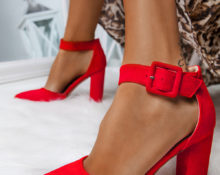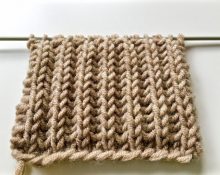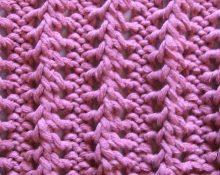Today, things knitted with very cozy, soft and voluminous English elastic are extremely popular. Otherwise it is called patent or more euphoniously - brioche. This is also what airy buns are called, and this is a very correct comparison. The pattern knitting technique allows you to create a very interesting effect if you use yarn of two different colors. The result is a double-sided fabric with vertical stripes - ideal for knitting snoods, scarves, hats and generally any warm products.
Two-color elastic band knitting
Things knitted using this technique really look very interesting and extraordinary. You definitely won't go unnoticed if you wear such a striped product. If you choose this pattern for knitting a cardigan or sweater, know that the horizontal stripe in the clothing makes the silhouette slimmer. And for such a voluminous elastic band as English, this is a significant plus.
Most often, of course, this technique is used for knitting snoods and scarves - where the reverse side of the product is very important. Here it is identical, only the colors of the stripes change.By the way, there are other types of elastic bands in which you can alternate colors in a special way. Yes, even horizontal stripes in a regular 1*1 or 2*2 elastic band can be called a two-color elastic band. But brioche elastic is the most impressive, popular and elastic - ideal for winter clothes. By the way, there may also be a third color in the fabric, but this is a more complex knitting technique. One of the threads may have a melange color, changing color along its entire length. The result will be a very interesting effect.

How to knit: instructions, patterns
To knit in rotary rows, cast on an odd number of stitches using thread of the first color. There is no need to tighten the thread too much, because the point of the English elastic is its looseness. Then the fabric is knitted according to the following pattern.
IMPORTANT! We use either circular knitting needles or straight double-edged knitting needles for knitting - we will need to turn the knitting over, let's say, in unexpected places.
- 1st row - we knit the front side of the fabric with a thread of the second color, repeating 1 front, 1 yarn over, 1 slip.
- 2 r. - wrong side. We knit with a thread of the first color in this way: 1 yarn over, slip 1, 1 knit stitch (together with the yarn over from the previous row behind the front wall).
- 3 r. - we remain on the wrong side, move to the opposite end of the knitting needle and use a thread of the second color: 1 purl (together with the yarn over from the previous row behind the front wall with a loop), 1 yarn over, remove 1 loop without knitting.
- 4 rub. - we knit from the front side using the thread of the first color: 1 yarn over, remove 1 loop, purl 1 together with the yarn over from the previous row.
- 5 rub. - and again knit from the front side, moving to the other end of the knitting needle, use a thread of the second color: 1 knit one together with the previous yarn over, 1 yarn over, 1 loop removed.
- 6 rub. - repeat row 2. Alternate rows 2–5 until the end of knitting.

In the case of circular knitting, which is convenient for cuffs, hats and snoods, the process is a little different. You need to cast on an even number of loops (well, plus one loop to connect the work into a circle) with a thread of the first color.
IMPORTANT! Be sure to check that the loops are placed correctly before closing the circle. The inlaid edge should all be on one side, otherwise the product will be twisted.
- 1st row - preparatory. We knit with a thread of the second color. We throw the thread, folded in half, onto the right knitting needle with a loop (or a working one, if you are using stocking needles), remove the first loop from the left knitting needle to the right one, purl 1, remove the double crochet loop (thread before work).
ATTENTION! Use a marker because... in circular knitting it is easy to miss the beginning of a row, but they are not knitted the same way.
- Row 2 – knit with thread of the first color. Make sure that at the beginning of the row two threads of different colors do not cross. We knit a double crochet stitch together. We remove the purl loop with a crochet (thread before work).
- 3rd row - knit with a thread of the second color. We remove the first front loop with a double crochet, and we knit the purl with a double crochet from the previous row together. Then we repeat rows 2 and 3 along the entire length of the product.
It seems to me that the most successful things knitted with such an elastic band will be hats and snoods. They can be knitted in the round and then worn either side. According to my taste, one of the colors is better to choose gray. A huge number of shades are combined with it, so the result can be a bright or delicate canvas. But the fact that it will be an original accessory is 100% guaranteed.


 0
0





